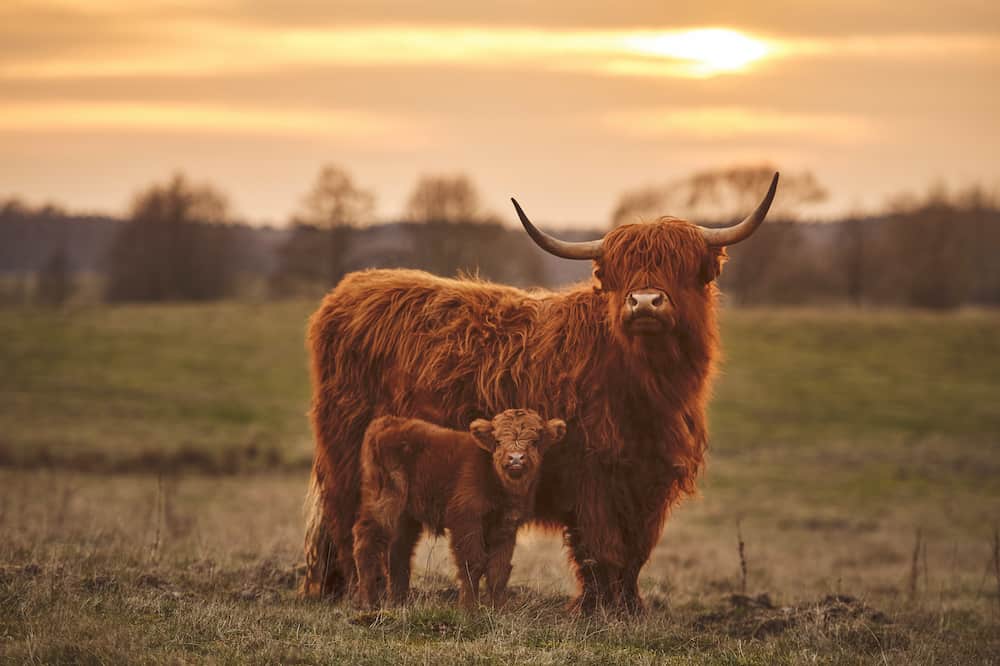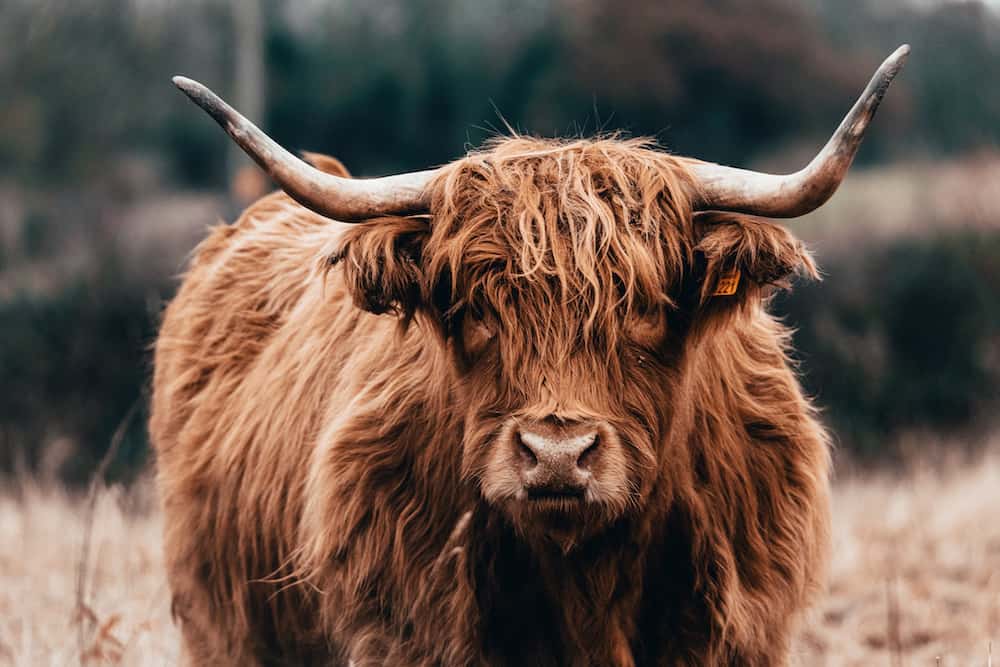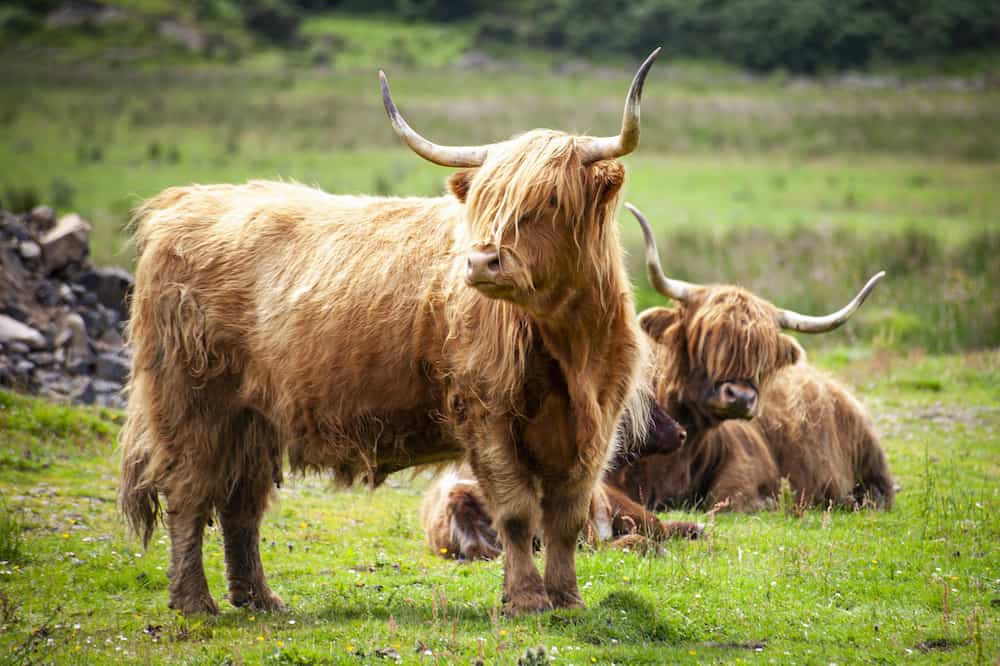Raising cattle is on your homestead is a way to earn money and provide for your family. One breed to consider is Scottish Highland cattle. They produce excellent quality beef and are very hardy, easy to train, docile, interesting, adorable, and intelligent. With property and the means to care for them, they can be a good investment and choice for livestock to raise for meat.
Scottish Highland Cattle
Aptly named, Scottish Highland cows originated from Scotland and were commonly seen in the Highland region. This area was known for harsher weather and other conditions where the cattle had to adapt quickly. That caused the region to be hard to survive in, so only the strongest of the bunch survived.
That made the young of the next generations even stronger and more adaptable to the area’s difficult conditions.
There were originally multiple variations of what this type of cattle looked like, but many died. Still, the breed has many unique characteristics because of their breeding habits.
Crossbreeding
There have been some benefits that have come from crossbreeding with this strong breed of cattle. One of these is that other breeds now have the genetic makeup of this breed of cattle. The genetic makeup of the Scottish Highland breed is tough and has become even stronger over time.
They have evolved to deal with tougher conditions and to fight off sickness. This is passed to whatever breed they are crossbred with, which makes them more resistant to diseases.
This can make other cattle breeds stronger over time and allow their females to give birth easier. It will bring the benefits of the Scottish Highlander cattle’s evolution and allow others to share the same benefits as they crossbreed.
Another is diversity. Meaning if cross breeding continues, we might see an even more diverse population of cattle in the future.
What Does Scottish Cattle Look Like?
With their long hair, many people find Highland Scottish cattle appearance to be adorable. As one of the oldest cattle breeds recorded, they have had a long history of crossbreeding and changes throughout their lifespan. Some of their most outstanding features include:
Head Hair
Both the bulls and cows are known for having hair at the top of their head. This often looks like it is styled to grow over their eyes. This is why they are sometimes also called The Hairy Cow.
Multiple Fur Colors
Older versions of this breed were found with black fur or have a reddish tint to their skin. Due to crossbreeding, we now see many different fur colors among Scottish High bulls and cows. You can find some with yellow, silver, white, black, or reddish-brown fur. However, the most common ones are those with a darker reddish-brown color.
Long Eyelashes and Forelocks
These animals also have longer eyelashes and forelocks, giving them an endearing quality when you see them up close. This feature, though, is mainly for protecting their eyes from cancer and other illnesses such as IBK (infectious bovine kerato-conjunctivitis or pinkeye).
Are Scottish Highland Cattle Friendly?
This breed of cattle also has a great personality, especially in terms of friendliness and docility.
Friendliness
This breed of cattle tends to be very friendly with people making them among the best farm animals to raise. Such a personality makes them a great addition to those who already have other farm animals on their property.
They are well-behaved, but they also like to have attention and will tend to follow you when you’re there. They may also fight a bit for your attention. However, this can be a very endearing quality that people like.
Most of the time, they are very sweet to everyone they meet. The one exception to this is when they feel that their young are in danger.
If either the bull or cow feels like you will hurt or harm their calf, they can become aggressive to protect them. Otherwise, they are friendly creatures that will allow you to get close to them.
Docility
The Scottish Highland breed of cattle is docile and does not get stressed easily. This makes them easy to breed, raise, and train without much trouble. Another very gentle breed to raise are Brown Swiss cattle.
The cattle are very smart animals and can actually be trained in many ways that other breeds do not have the capacity for. Though they are an animal with horns, they tend to be very easy to work with.
There is nothing you have to do with the horns. If you are showing the cattle, their horns must remain. If you choose to raise them without horns to make it easier to slaughter in a facility, rather than dehorning them, it’s best practice to take action when they are very young. Disbudding is encouraged over dehorning. Disbudding involves removing the horn-producing area. You do this before the horn is even present. It’s the least painful and stressful to the cattle.

How Are Scottish Highlander Cattle as Parents?
The female cattle can give birth each year, and often birth until their 19th year. That’s because baby calves tend to be smaller than you would expect. This makes birthing a lot easier on the mother’s body and negates the need for any assistance in most cases.
Their calves are also able to stand and walk as soon as they are born. They will also immediately know where their mother is. With that in mind, when the female cattle give birth to a calf, here are what you’ll expect from each of the parents:
Highland Bull
While the mother is taking care of their calf, the Scottish Highland bulls will typically be away and spend time using their horns to get some brush to eat. They feed and then bring back food for the mother.
When the calf starts to grow, the bull takes it out to train it to find its own food. Bulls typically spend more time with their family than other breeds. What Do Bulls Eat
They also tend to be big breeders that can be aggressive during this process. That means they keep their breed alive and well with ease.
Cows
This breed’s females are more protective over the young and will be very devoted to their family. They also produce a large amount of milk for feeding. Their milk is high in butterfat and is rich, so the young will have all the nutrients it needs to speed up its growth process.
How Big Do Scottish Highland Cattle Get?
Scottish Highlander cattle weigh between 60 and 70 pounds when they are born. They grow very quickly, which makes them ideal for farmers who intend to breed them for meat. Of course, there is a difference in the size of the male and female cattle.
Bulls
The size of a Scottish Highland bull is around 1,800 pounds once they have matured completely. This is a typical size because they do grow to a large size fairly quickly. This leads to smaller cattle, around 36 inches around the hip, to be considered a miniature cattle breed.
Most cattle of this breed will be between 48 and 50 inches around their hips.
Cows
The Scottish Highland cows are a bit smaller than the bulls, but they are still large. They weigh an average of 1,100 pounds when fully matured.
Raising Scottish Highland Bulls and Cows
Like any other animals you want to raise, you should understand the needs of this cattle breed. Luckily, there are only a few requirements for them to thrive. After all, they are among the strongest of their kind.
As mentioned, they come from some of the toughest ancestors, so they’re able to adapt well and live a long life. They can also survive in areas where other breeds might not be able to. Here are some of the basic needs of the Scottish Highlander cows and bulls.
Shelter
Scottish Highlander cows and bulls don’t need a lot for lodging. Shelter-wise, they would need a place to stay at night or for safety. A simple cattle shed will serve many purposes. The good thing is that a simple barn would be enough. You’ll need something secure to keep them safe from predators such as coyotes. Learn about a cattle shed.
Depending on the climate, they’ll need access to shade as well as an area to keep them protected from storms and inclement weather.
They would also need an area where they can forage or search for food. Grazing would also ensure they stay healthy and tough.
Food
Highlands are healthy and hardy animals. They do well browsing for food, including on land with brush and areas with poor pasture. This makes them a good addition to a homestead with ample grazing. They prefer to graze during daylight hours. Provide access to fresh water as well.
The Scottish Highland breed of cattle will also eat things that other breeds will leave behind or won’t touch. They will do well with grass and hay along with grains, including barley, cereal grains, and/or corn and wheat silage. Any greenfeeds should suffice.
It’s important to note what’s on your property to avoid poisonous plants. There are many that will harm cattle and livestock. Some of them include mushrooms, arrowgrass, tall larkspur, low larkspur, and showy milkweed. Learn what does clover do to cattle.
Climate
This breed of cattle doesn’t require certain temperatures for them to thrive or stay healthy. As such, the weather is not a big issue.
They tend to love the colder weather, which allowed them to be bred in areas like Scandinavia and Alaska. Still, they are also great in warmer weather. That is why they can also be found in the US southern states. Some are raised in Louisiana, Georgia, and Texas.
That said, if you intend to raise this breed of cattle in areas with a hot climate, you will need to ensure that their hair is cut short to keep them cool.
If not, they may have issues staying at an optimum temperature and might become sluggish or lethargic.

What Are Scottish Highland Cattle Used For?
Raising your own Highland cattle comes with lots of uses, from having your own food source to gaining profit. There are many uses for Scottish Highland cattle.
Own Consumption
With the amount of beef that comes from this breed of cattle, they are popular for consumption. The cows also produce milk.
Scottish Highland Beef
The cattle beef has a marbled effect that makes it unique. It also has a savory flavor that is distinct from other beef dishes and is lower in cholesterol. Use it in stews with potatoes, peas, and carrots during the winter for a hearty meal.
You can also brown the meat and serve it as a main dish, stir fry it with vegetables, or fry it and serve with cheesy potatoes or mac n’ cheese for a special occasion. There are many other ways to cook and eat their meat, and they have recipes made specifically for cooking and serving it.
Another excellent cattle breed for beef are Limousin cattle.
Milk
Highland Scottish cows produce up to two gallons of milk each day. Compare this with cows such as Lakenvelder cattle which produce around five gallons per day. People don’t typically raise them solely for their milk producing capabilities as production cows produce more milk. If you are looking to raise cows for their milk on your backyard farm, consider mini milking cows instead.
However, one Highland cow will produce more than enough milk for a family. Like Brown Swiss cows, their milk has a high butterfat content which can be used for drinking, baking, and cooking. For instance, the butterfat from the fresh milk will help make your stews thick and filling.
Selling
You can also raise them to sell their milk and meat. Cows will produce milk through the winter. This is due in part to their hardy nature. Some cow breeds don’t produce in the winter months. This makes selling milk year round a viable opportunity.
Breeding
Additionally, if you have enough space and a good number of cattle, you can also consider selling live calves to homesteaders and breeders.
Land Maintenance
Letting them graze on any land or pasture you have also will help maintain your property. If you’re raising them for meat production, as they grow they gain two pounds of weight per day.
Since they have longer horns, they are also great for removing brush and clearing land. A fold or a group of the Scottish Highlander breed will get the job done in little time.
Are There Highland Cows in the US?
Yes, there are Highland cows in the United States. They are hardy animals and can adapt to most climates. Providing shelter from rainstorms and cold weather as well as shade, they will thrive in most places with the proper care.
Scottish Highland Cattle: Are They Right for You?
If you are thinking about acquiring the Scottish Highlander cattle breed for your farm, you will want to consider the positives and negatives.
With their sunny disposition, friendly demeanor, and fantastic ability to survive in many different conditions, they are ideal for most farmers.
If you want to add this breed of cattle to the animals that you already have, you don’t have to be too careful about it. They will likely get along with your other animals, and they are a good source of milk and meat at any time of the year.
They will get to know and love those around them and develop an even more unique personality as you get to know each one of them.
These cattle are also very independent and don’t need a lot of care. Therefore, they are great for those who may not have the time to dedicate to more temperamental animals.
See related: The Backyard Cow: Guide to Keeping a Productive Family Cow

